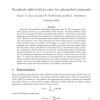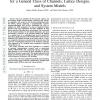85 search results - page 7 / 17 » Worst Cases and Lattice Reduction |
APCCAS
2002
IEEE
14 years 14 days ago
2002
IEEE
Designof portablebattery operatedmultimediadevices requires energy-ecient multiplication circuits. This paper presents a novel approach to reduce power consumption of digital mul...
ISQED
2007
IEEE
14 years 1 months ago
2007
IEEE
The deep submicron (DSM) semiconductor technologies will make the worst-case design impossible, since they can not provide design margins that it requires. Research directions sho...
ANTS
1994
Springer
13 years 11 months ago
1994
Springer
We propose a fast variant of the Gaussian algorithm for the reduction of two{ dimensional lattices for the l1; l2; and l1;norm. The algorithm runs in at most O(n M(B) logB) bit op...
JC
2006
13 years 7 months ago
2006
We study the problem of multivariate integration over Rd with integrands of the form f(x)d(x) where d is a probability density function. Practical problems of this form occur comm...
TIT
2010
13 years 2 months ago
2010
The work identifies the first general, explicit, and non-random MIMO encoder-decoder structures that guarantee optimality with respect to the diversity-multiplexing tradeoff (DMT),...


